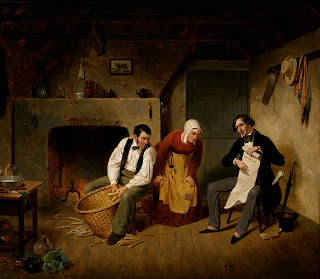Sorry for the long delay in posts. The start of school at work and home, ...'nough said.
The last couple of days at the Smithsonian we spent working on our presentations. They showed us how to record on Audacity and then on VoiceThread. Our assignment was to record a podcast based on the artwork we had selected. Here is the painting I selected oh so many months ago ...
Achelous and Hercules.1947. Thomas Hart Benton. Born: Neosho, Missouri 1889. Died: Kansas City, Missouri 1975. tempera and oil on canvas mounted on plywood. 62 7/8 x 264 1/8 in. (159.6 x 671.0 cm.). Smithsonian American Art Museum. Gift of Allied Stores Corporation, and museum purchase through the Smithsonian Institution Collections Acquisition Program. 1985.2.
I have decided not place my podcast here for two reasons. One, the idea of someone hearing my recorded voice is distressing to me. The second (and real reason), is that I don't know how to get the audio to link onto the blog. But I have a better idea. Here are three podcasts by different students from across the country. I pulled them off the Smithsonian website, thank you Addie and Victoria for showing us these; they are awesome. The first one is by a sixth grader. It is tremendous and points to how creative a kid can get if you give them a chance.
Butte de Mort, Sioux Burial Ground, Upper Missouri. 1837-1839. George Catlin. Born: Wilkes-Barre, Pennsylvania 1796. Died: Jersey City, New Jersey. 1872. oil on canvas. 20 x 27 3/8 in. (50.9 x 69.4 cm). Smithsonian American Art Museum. Gift of Mrs. Joseph Harrison, Jr. 1985.66.475.
The other two below are different takes of the same painting. One is by a second grade student, another by a senior. It shows that the idea of podcasting works for all age of student. Yes, my current students ... you will be podcasting this year!
Dust Bowl. 1933. Alexandre Hogue. Born: Memphis, Missouri. 1898 Died: Tulsa, Oklahoma 1994. oil on canvas. 24 x 32 5/8 in. (61 x 82.8 cm). Smithsonian American Art Museum. Gift of International Business Machines Corporation. 1969.123.
Cool, don't ya think?
On Friday of the conference, we gave our five minute presentation. Some incorporated their podcasts, some presented in PowerPoint, others in a program called a Prezi. Everyone's was really cool. In a week of in class lectures, in the exhibits gallery talks and hands on technology master classes, we all created something quite cool. Here is mine...
Dave McIntire's Manifest Destiny Prezi
Its weird to be finishing this a little more than a month after getting back home. Both the Presidential Academy and the Clarice Smith National Teacher Institute were game changing for me.
The Academy forced me think like a scholar again. Being the most educated guy in the classroom can cause you to get a little complacent. I always tell my students I don't ask them to do anything I'm not doing so the Academy allowed me to put my money where my mouth is. It also let me explore beyond my curriculum. I'm really excited to bring my newly minted Civil Rights module into the classroom in January.
The Smithsonian gave a whole new language and a whole new skill set to use on my kids. Using art as more than glorified clip art. Using art to introduce ideas and concepts as well as linking ideas together in a way that is engaging.
This should be the end of this blog but a few students, parents and friends have asked if I'm going to keep the blog going when I finish this entry. One of the program coordinators has asked if I would continue it and talk about how the integration of what I learned over the summer into the classroom is going. I'm game if you are so here is what I think I'm going to do from here on out.
I'm gonna post but I'm also going to ask my current student, parents and friends to weigh in by commenting. You'll have to join the blog to comment, including those of you read and comment on it via Facebook. I'll just want place to follow if that okay? I've used some of the Smithsonian activities in the classroom so far and I will post on how I think it went. Students, what are your thoughts? (I can only imaging my friends and colleagues are tired of my voice so I want yours). Parents and my friends (teacher type or not), you too! I know of a couple program administrator types who are lurking in the ether out there, you weigh in too!!! If this becomes OUR blog, then I will keep it going. If not, then, ok.






































